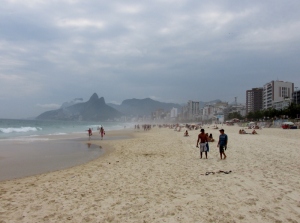It’s been exactly three months since I first came to Rio de Janeiro. Before starting my study abroad program I had spent the last half of July working in Lima and the Peruvian Amazon. On August 5th I finally took a bus to Lima’s airport and flew during the night to the Galeão International Airport in Rio. Just yesterday I was having dinner with my host family and we talked about that first day when I moved into their apartment.
Three months and today is the first day I post an entry about a trip in Rio! As I have written several times before, one of my main goals for my program was to avoid becoming yet another tourist in this city. I understand why many friends tend to disagree with my goal, but having this objective in mind was a mix of previous experiences in other regions of Brazil, some geography and sociology classes, and the desire to have a different approach towards one of the world’s most dynamic metropolis.
After countless conversations with my host family, classmates, professors, and many people I have met so far, I finally felt ready to visit and write about some of Rio’s neighborhoods. So here it goes.
Last weekend I packed a backpack and left my apartment early in the morning. I took a bike (every month I pay about $4.00 to have access to one of Rio’s biking programs) and began my trip to a neighborhood in Rio’s southern area: Ipanema. I had planned to visit a number of places that my host family had suggested, but I mainly wanted to spend a day walking around Ipanema’s streets without a set destination.
You may recognize the name Ipanema. The song “Garota de Ipanema” (“The Girl from Ipanema”), written and composed by João Gilberto and Stan Getz in 1962, made the name of this neighborhood widely known (here’s a version of the song for you to enjoy:
I biked for about 25 minutes before reaching Ipanema and left my bike to start walking. My host family truly wanted me to visit the Praça Nossa Senhora da Paz and the Igreja Nossa Senhora da Paz, so that is where I went first. Thinking about this entry I stopped to look for “good” pictures but in the end decided to submit the ones with cars, buses, and people walking through the church and park. In my experience, contrasting images of nature, people, and culture is one of Rio’s main characteristics.

Not a great picture of the Nossa Senhora da Paz church, but the contrast is certainly common in Rio’s streets.
I bought two oranges from a street market and sat in the park to read “Perto do Coração Selvagem” (Near to the Wild Heart) by Clarice Lispector – a fantastic writer. Unfortunately it was a rainy day so reading outside was not a great plan. I entered a small shop to buy water and asked if they had any suggestions for my trip. The guy in the shop sent me to visit the theater Rubens Correa and the cultural center Laura Alvim, and of course I followed his instructions. As I visited these and other places I kept asking people if they had any suggestions for my day in Ipanema. I ended up having lunch in a sandwich-shop with incredible natural juices and a nice couch to read.
I finished Lispector’s book in the afternoon and kept walking. The weather had not improved much but several people were now in the beach (my guess is that the temperature never dropped below 70 degrees.) I knew friends and family would appreciate a picture or two from Ipanema’s beach so I walked by the beach for about forty minutes. When I finally reached the end of Ipanema (where Copacabana starts) I took another bike and began my trip back to my apartment.
As I walked through this neighborhood I kept thinking about my “don’t be a tourist” goal. Was it worth it? Did it make any sense to wait some time before going on these trips? Would reading Lispector’s book in a sandwich-shop have been any different two months ago? Well, I suppose any “evaluation” of my goal will have to come from my overall experience in Rio de Janeiro. Two months ago I wouldn’t have known that, following a common cultural dynamic in the country, Lispector’s modern language had been widely criticized throughout Brazil as an attempt to move away from other more traditional styles. It may seem as small detail, but understanding why different literary circles in Brazil reacted differently to “Perto do Coração Selvagem” is the result of countless conversations during these three months.

